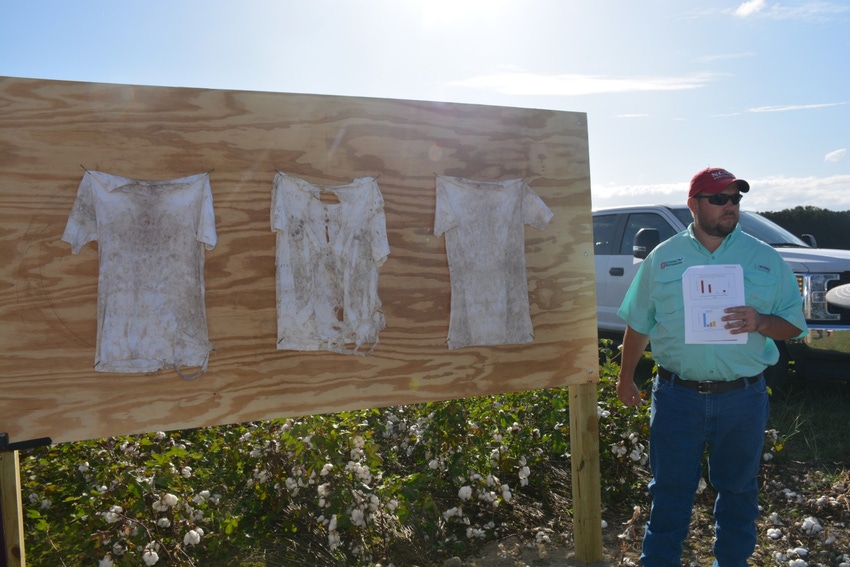
Three dirty t-shirts, two of them all cotton and one of them a 50-50 cotton-polyester mix, played starring roles at this year’s Cotton Field Day at the Upper Coastal Plain Research Station in Rocky Mount.
North Carolina State University Cotton Agronomist Guy Collins displayed the three t-shirts to illustrate the benefit of cover crops and to hit home the point that cotton beats polyester by far as a sustainable fabric.
North Carolina State is encouraging cotton farmers to consider implementing cover crops to better manage weeds, conserve soil moisture, reduce erosion, and improve water infiltration. A key benefit of cover crops is increased organic matter, which results in higher microbial activity in the soil.
Collins explained that the three t-shirts do a great job illustrating the point.
Shirtless
The first t-shirt is 100 percent cotton buried underground for four and a half weeks in a field of regular no-till with no cover crop.
The second t-shirt was buried for the same length of time two inches deep under a heavy rolled rye cover crop system.
The third t-shirt was buried for the same time at the same depth under the same tillage system, but it was a 50 percent cotton, 50 percent polyester blend.
“The first shirt shows you cotton can degrade over time. You can see a few holes here and there,” Collins said of the cotton t-shirt that was under the regular no-till system with no cover crop.
“In this second shirt, you see a lot of shredding, a lot of different holes and quite a bit of degradation. This is basically a reflection of that microbial activity that results from increased organic matter and how well it can degrade this fabric. The only difference is the heavy rolled rye cover crop system associated with this t-shirt,” Collins said.
“This third t-shirt was buried under the rye at the same proximity. There is hardly any degradation at all. The only difference? This shirt is half cotton and half polyester,” Collins said.
The cotton-polyester t-shirt that fared better than the all-cotton t-shirts illustrates the sustainability of cotton, compared to synthetic fibers, hitting home the point that cotton is more environmentally friendly than polyester, according to Collins.
Contamination
At the field day, Collins discussed the microfiber contamination issue that is impacting both fresh water and salt water. Synthetic microfibers don’t degrade rapidly and often end up in places where they are unwanted which is raising alarm with conservationists.
Collins shared research by Cotton Incorporated that shows in salt water over a 30-day period, cotton degrades 67 percent, cotton-polyester degrades 33 percent and polyester degrades zero percent.
In fresh water over a 30-day period, cotton degrades 86 percent, cotton-polyester degrades 37 percent while polyester degrades zero percent.
“This is a very important message that we have to get out to the general public, not just cotton growers. Cotton is a crop that can be sustainably grown as we have illustrated with this tillage system. Not only that, the end product is a sustainable product. Cotton fiber degrades much quicker in the natural environment than manmade fibers. This is a good selling point for cotton that we really need to get out and emphasize to the general public,” Collins said.
Collins; Dr. Charlie Cahoon, North Carolina State Extension weed specialist for corn and cotton; and Dr. Rachel Vann, North Carolina State Extension soybean specialist, who has done previous research on cover crops in cotton, are conducting tests across the state, comparing a no-till system with a heavy rye cover crop to regular no-till with no cover crop.
They are seeking ways to optimize cover crop benefits in cotton and soybeans.
Collins also noted the research shows higher soil moisture in regular no-till compared to no-till with the heavy rye cover crop before the cover crop is terminated. The green cover crop pulls much of the water out of the ground.
“This could be both good and bad. It depends on the kind of year we are encountering,” Collins said.
Biomass
In years that are abnormally cool and excessively wet as farmers get into the planting season, waiting to terminate the rye cover crop right before planting could be an advantage because it will pull some of the excess moisture from the ground under conditions that are too wet or too cool and allow those fields to be planted earlier.
In years where it is warmer and dryer at planting, Collins noted it is better to terminate the rye at least a week or two prior to planting to give you another chance at another rain event between the day you terminate your cover crop and roll down the rye before you plant your cotton and ensure you have enough moisture at planting.
In years where there is periodic drought stress, cover crops can pay off in cotton because they allow the crop to retain soil moisture longer.
“Throughout the years, what we do see most of the time is an advantage with this rye system in regard to moisture retention. It means we can take an inch of rain, or however much rain we encounter, and make it last two to three to four days longer than when we would not have that cover. In years like that, it could mean a major difference in yield,” Collins said.
Vann notes that an early planting date for cover crops helps to maximize biomass, ideally by mid-October for cereal rye, but she admits that can be a challenge because cotton and soybeans are often still in the field and a busy harvest is often underway.
In later planted cover crops, Vann encouraged a nitrogen fertilizer application on the rye to help it overcome late planting.
“Some farmers in the state aerially seed their cover crop into soybeans or cotton prior to defoliation. That can work well, but success in aerially seeding is heavily dependent on soil moisture and rainfall,” Vann said.
Maximizing biomass is an important component of cover crops and Vann noted that one way to help with biomass is through seeding rates.
“Recent research across the Southeast indicates that farmers may be able to drill less rye seed per acre than previously thought without impacting ultimate biomass accumulation. This should allow farmers to more economically implement this system,” she said.
About the Author(s)
You May Also Like






